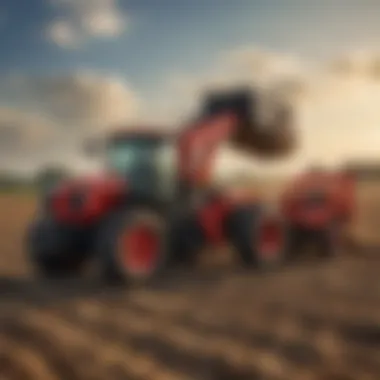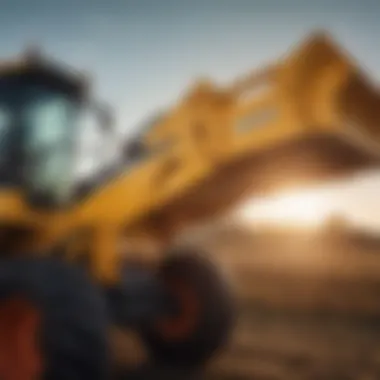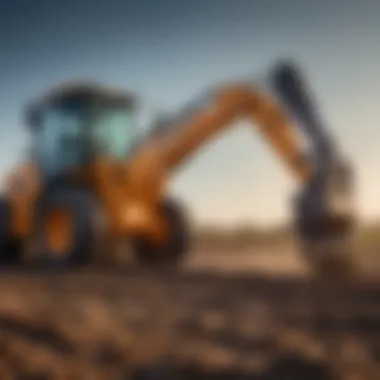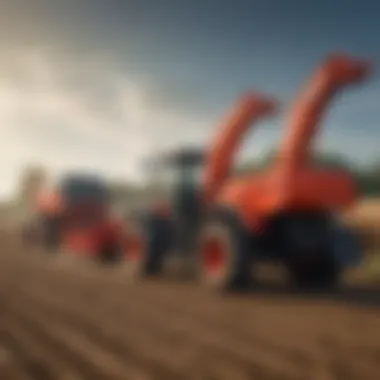Koyker Loader Attachments for Agricultural Efficiency


Intro
Koyker loader attachments are instrumental in transforming the landscape of agricultural operations. By providing the flexibility to tackle a wide array of tasks, these attachments offer farmers and horticulturalists a means to enhance their productivity and efficiency. With an understanding of the different types of attachments available, their specific applications, and the maintenance required, one can make informed decisions to optimize their farming practices.
Agriculture is not just about planting and harvesting crops anymore. Nowadays, the integration of technology and efficient equipment plays a vital role in success. Koyker loader attachments invite a revolution in enhancing operational capability. This article intends to guide both novices and seasoned farmers in delving deep into the essence of Koyker loader attachments.
Key Concepts and Terminology
Understanding the key concepts related to Koyker loader attachments is vital for maximizing their utility. Here are delineated terms and definitions that lay the groundwork for more advanced discussions.
Basic Definitions
- Loader Attachment: An implement that connects to a loader tractor to perform specific tasks such as lifting, pushing, or loading material.
- Hydraulic System: A method using fluid power to generate movement, essential for the operation of loader attachments.
- Versatility: The capability of an attachment to perform multiple functions across various applications.
Historical Context
The Koyker Company has a rich history of producing loader attachments since its inception. Starting from simple designs, the company has evolved with agricultural needs. The push for more productivity led to innovations that have reshaped how equipment is utilized on the farm.
As farmers faced challenges like labor shortages and the need for efficiency, Koyker responded with versatile solutions. It is crucial to note that each attachment designed by Koyker aims to address specific challenges in daily farm operations.
Recent Innovations and Trends
Agriculture constantly evolves. Innovations in Koyker loader attachments reflect the industry's shift towards maximizing efficiency and sustainability.
Technological Advancements
Recent technological improvements enhance the capability of Koyker loader attachments. Features like quick-attach systems enable farmers to change attachments quickly, adapting to different tasks without losing time.
Moreover, advancements in hydraulic technology ensure that these attachments operate more smoothly, allowing for greater lifting capacities and control.
Sustainable Practices
Sustainable farming has entered mainstream discussions, pushing professionals to consider attachments that contribute to resource conservation. Koyker’s designs include features that minimize soil disturbance and optimize material handling.
The adjustments brought by sustainable practices are visible in reduced fuel consumption and lower emissions, aligning with modern ecological standards.
Practical Applications and Techniques
To utilize Koyker loader attachments effectively, understanding their practical applications is key. This section outlines their uses and offers guidance through the selection process.
Step-by-Step Guides
- Identify Your Needs: Evaluate the specific tasks you require assistance with on your farm, such as loading feed, clearing snow, or lifting bales.
- Choose the Right Attachment: Investigate available Koyker loader attachments tailored to your tasks. These include but are not limited to:
- Regular Maintenance: Prioritize maintenance to ensure longevity and effectiveness. Regularly check hydraulic fluid levels and inspect for wear on moving components.
- Bucket: For loading and moving dirt or debris.
- Grapple: Ideal for lifting logs or debris.
- Forks: Best for handling pallets or heavy items.
Case Studies
Several farms utilizing Koyker loader attachments demonstrate how their efficiencies have improved significantly. A recent case in Iowa showed how a farm increased its productivity by 40% after implementing various attachments effectively to redistribute task loads.
Prologue to Koyker Loaders
Koyker loaders are pivotal in the realm of farming and agricultural efficiency. They provide essential support in various farm tasks, designed to enhance both the speed and effectiveness of operations. Understanding Koyker loaders is crucial for those involved in agriculture. This section examines their overall function and significance.
Overview of Koyker Loaders


Koyker loaders are versatile machinery that can be attached to different types of tractors. Their primary purpose is to assist in lifting, moving, and loading materials with ease. Koyker loaders come with a variety of attachments, making them adaptable to different agricultural needs. Farmers can use them for tasks such as loading hay, transporting soil, or handling heavy equipment.
These loaders are built to endure rugged conditions often seen in farming environments. They are designed with user-friendly controls, allowing operators of varying skill levels to utilize them effectively. The loaders contribute to not only productivity improvements but also to the overall safety of farm operations by reducing manual handling.
Importance in Modern Agriculture
In modern agriculture, efficiency is more important than ever. The increasing demands on production require farmers to maximize the output of their equipment. Koyker loaders play a significant role in achieving this goal. They streamline various processes, enabling farmers to complete tasks more quickly than traditional methods would allow.
Moreover, these loaders help reduce labor costs and physical strain on workers. The ability to perform multiple functions with a single machine increases their value on the farm. Farm owners benefit from quicker turnaround times and the ability to allocate resources more effectively, ultimately leading to enhanced economic sustainability.
"Koyker loaders can transform the way farms operate by enabling faster and safer methods of handling materials, thus promoting a more efficient agricultural workflow."
In summary, Koyker loaders are essential tools in modern farming, providing numerous advantages that can enhance operational efficiency and productivity.
Types of Koyker Loader Attachments
Koyker loader attachments are essential for enhancing agricultural efficiency. They expand the capabilities of loaders, making them versatile tools for various tasks. Understanding the types of attachments available helps farmers and agricultural professionals select the best options for their needs. This section examines different categories of attachments, focusing on how each adds value to agricultural operations.
Buckets
Buckets are fundamental attachments and come in several types, each catering to specific tasks. They significantly improve the loader's ability to transport materials swiftly and effectively. Here are some notable bucket types:
Standard Buckets
Standard buckets are common in many agricultural settings. They usually feature a medium capacity, which makes them useful for general material handling tasks. The key characteristic of standard buckets is their design, which allows for efficient loading and unloading of soil, gravel, and other materials. Their beneficial aspect is versatility; they can perform various tasks, from digging to transporting. The unique feature of standard buckets is their moderate size that suits most loaders, providing a balance between capacity and agility. However, they may fall short in handling more substantial loads, which can be a disadvantage in heavy-duty scenarios.
Heavy-Duty Buckets
Heavy-duty buckets are designed for tougher jobs. They feature reinforced structures that can withstand the strain of lifting heavier materials. The key characteristic of heavy-duty buckets is their higher durability, often made from stronger materials than standard options. This makes it a popular choice for operations involving dense materials like rocks or compacted soil. The unique feature of these buckets is their thicker walls and added strength, providing better resilience under pressure. On the negative side, their weight can influence the loader's overall balance and fuel consumption.
High-Capacity Buckets
High-capacity buckets are ideal for large-scale agricultural operations. They are designed to carry a significant volume of material in each load. The key characteristic of high-capacity buckets is their expansive size, allowing more substantial transport per trip. This makes them a beneficial option for reducing the number of trips required for large tasks, which saves time and labor. The unique feature is their design, often outfitted with broader openings and enhanced lifting capabilities. However, the limitation can be that they may not be suitable for narrow spaces or precision tasks due to their size.
Forks
Forks are critical for lifting and moving specific materials, particularly pallets and large objects. They extend the loader's versatility, especially in material handling.
Pallet Forks
Pallet forks are designed to lift and transport pallets directly. A key characteristic of pallet forks is their tines that can adjust to various widths, allowing flexibility in dealing with different sizes of loads. This adjustability makes them a popular choice among farmers for handling various goods, from bags of feed to construction materials. The unique feature is their ability to handle items that standard buckets cannot easily manage, like bulk commodities. However, they can be ineffective when dealing with loose material or soil.
Root Grapple Forks
Root grapple forks are specialized tools for moving heavy or bulky items, especially in rural areas. The key characteristic is their claw-like design, which allows for grabbing and lifting irregular shapes. This makes them a beneficial choice in landscaping and clearing tasks, where roots and stumps may need extraction. The unique feature here is the grappling mechanism, which provides better control over the load, leading to increased efficiency in clearing debris or moving logs. A disadvantage, however, can be potential overloading if not monitored, leading to strain on the loader itself.
Blades
Blades serve multiple roles in land preparation, especially grading and leveling tasks. Their presence speeds up processes that traditionally require more manual labor.
Land Leveling Blades
Land leveling blades are primarily used for grading soil. The key characteristic of these blades is their adjustable angle, enabling operators to achieve the desired slope or flatness. It is a popular choice for farmers preparing fields for planting, as it ensures the ground has a consistent level. This attachment's unique feature is its ability to handle significant volumes of earth, facilitating better land preparation. On the downside, it may not be effective in very rocky or uneven terrains, where it can encounter resistance.
Snow Blades
Snow blades are specifically designed for winter use, clearing snow efficiently from roads and fields. The key characteristic is their sturdy construction, which allows for pushing heavy, wet snow. This makes them a beneficial option in regions with frequent snowfall, ensuring accessibility during winter months. One unique feature is their angled design, which helps direct snow to the sides as it clears paths. However, they are less useful during the rest of the year, leading to potential storage concerns when not in use.


Grapples
Grapples are versatile attachments ideal for handling bulk materials and waste. Their effectiveness varies by type, but they are typically used for heavy lifting tasks.
Logging Grapples
Logging grapples are optimal for transporting logs and heavy timber. The key characteristic is their robust design to handle heavy wooden loads safely. This makes them a popular choice for forestry work, reducing the effort needed to move logs from site to site. The unique feature is the rotating grip, which allows better control during handling. Nevertheless, they may not be suitable for smaller or delicate items, which could get damaged during the log-handling process.
Material Handling Grapples
Material handling grapples are designed for a wide range of uses, increasing efficiency in various agricultural tasks. Their key characteristic is versatility, catering to both loose and bulk materials. This makes them a beneficial attachment when dealing with hay bales or large clumps of earth. The unique feature is their adjustable gripping mechanism, allowing for both delicate and heavy lifting. A limitation is that they can sometimes be challenging to control when handling smaller, more fragile materials.
Key Applications of Koyker Loader Attachments
Koyker loader attachments serve a crucial role in enhancing efficiency in agriculture. As various agricultural tasks demand specialized equipment, these attachments adapt to different challenges, offering flexibility and increased productivity. Understanding the applications of these attachments helps farmers make informed choices, ultimately improving their operational processes.
Field Preparation
Field preparation is the foundation of successful agriculture. Koyker loader attachments can significantly streamline this process. With attachments like heavy-duty buckets and blades, farmers can easily clear land, level plots, and prepare grounds for planting. This efficiency reduces the time and effort required, allowing for quicker cultivation cycles. Utilizing attachments tailored for field preparation helps in achieving optimal soil conditions essential for healthy crop growth.
Material Handling
Material handling encompasses various tasks such as transporting feed, fertilizers, or farm tools. Forks and grapples are particularly useful for these operations. Pallet forks enable users to lift and move pallets easily, while material handling grapples allow for the pickup of bulky items. This versatility cuts down on manual labor and reduces the risk of injury caused by lifting heavy objects. Hence, Koyker loaders with the appropriate attachments streamline workflows, contributing to increased overall efficiency in daily operations.
Landscaping and Construction
Landscaping and construction require precision and reliability. Koyker loader attachments like blades and grapples are effective in these scenarios. For instance, land leveling blades can create smooth terrains for gardens or building sites, while grapples handle debris or tree logs effectively. Such attachments not only speed up the process but also assist in achieving a more polished final result. This capability is essential for farmers and contractors alike, as it allows them to cater to diverse landscaping needs without requiring different pieces of equipment.
Waste Management
Waste management on farms, especially with organic waste, can be challenging. Koyker loader attachments simplify this task. Using grapples, farmers can efficiently collect and move waste, whether it’s leftover materials from harvesting or debris from land. The attachments guarantee effective waste handling, which is crucial in maintaining a clean and productive farming environment. This practice also supports sustainable farming efforts by ensuring that organic waste is managed responsibly.
Benefits of Using Koyker Loader Attachments
Koyker loader attachments play a pivotal role in improving workflow within agricultural settings. These attachments are crucial not only for efficiency but also for enhancing the overall productivity of farming operations. Understanding the multiple advantages of these tools allows farmers and agricultural workers to make more informed decisions about their equipment needs.
Increased Productivity
One of the most significant benefits offered by Koyker loader attachments is increased productivity. These attachments enable faster and more efficient handling of various tasks. For instance, using buckets for loading materials or moving soil can drastically reduce the time spent on manual labor. The result is that work is done more quickly, allowing farmers to focus on other essential tasks or complete their duties ahead of schedule.
"Efficiency is the key to thriving in modern agriculture."
Furthermore, having the right attachments can lead to better use of time and labor. When tasks such as moving feed, gathering hay, or transporting equipment are simplified, farmers can allocate resources more wisely. Essential work processes become streamlined, and total farm output improves significantly.
Versatility Across Tasks
Koyker loader attachments are designed to be versatile. Each attachment can serve multiple purposes, making them an essential part of any agricultural toolkit. For instance, a standard bucket can be used for loading materials, while a specific grapple attachment can aid in handling logs or bulky items. This adaptability not only saves time but also reduces the need to purchase different types of equipment for varied tasks.
The wide range of attachments available allows farmers to choose the best options suited for their specific environment and needs. This flexibility becomes invaluable when facing diverse seasonal requirements or unexpected challenges in the field. Farmers can easily switch from one task to another without needing to invest extensively in multiple machines.
Cost Efficiency
Investing in Koyker loader attachments can yield significant cost savings in the long run. By enhancing productivity and versatility, these tools reduce labor costs and minimize time spent on each task. Moreover, fewer purchases of specialized equipment mean reduced capital expenditure.
Additionally, many Koyker attachments are designed for durability and long-lasting performance. This minimizes maintenance needs and replacement costs resulting from wear and tear. With proper care, Koyker attachments can serve farmers well over an extended period, making them a wise investment.
In summary, the benefits of using Koyker loader attachments include increased productivity, versatility across different farm tasks, and cost efficiency. Leveraging these advantages allows farmers to work smarter, not harder, thus maximizing their overall operational efficiency.


Selecting the Right Attachment for Your Koyker Loader
Choosing the right attachment for your Koyker loader is a crucial step in maximizing its efficiency and function. The attachment you select can significantly impact the overall productivity of your agricultural tasks. Using mismatched or inappropriate attachments may lead to underperformance or damage. Thus, understanding the specific needs of your operations is vital. This section will explore how to assess your individual needs and the compatibility of attachments with your loader.
Assessing Your Needs
To begin selecting the most suitable attachment, identify the primary tasks you need to achieve with your Koyker loader. Consider the following elements:
- Common Tasks: What are the routine operations in your farm? For instance, moving soil, transporting pallets, or clearing snow can require different attachments.
- Soil Type and Condition: The type of soil in your agricultural area can influence the choice of attachment. Heavier and more robust attachments may be necessary for rugged terrain.
- Operational Scale: Consider the size of your operation. Larger farms often benefit from high-capacity buckets or grapples, while smaller farms may need more versatile options.
- Future Plans: Think about how your farming practices may evolve. Investing in a versatile attachment that can handle various tasks may save costs in the long run.
Inside the broader framework of agricultural operations, knowing your specific needs helps streamline productivity and maintain equipment longevity.
Considerations for Attachment Compatibility
Attachment compatibility with your Koyker loader ensures functionality and safety. Not all attachments will fit every loader model, so it is essential to consider the following factors:
- Loader Specifications: Check the manufacturer's specifications for your Koyker loader. This will detail the attachments that are compatible, including weight limits and connection systems.
- Hydraulic Requirements: Each attachment might have different hydraulic needs. Ensure that your loader’s hydraulic system can support the attachment you wish to use.
- Mounting Systems: Review the type of mounting system on your loader. Different attachments may require specific mounting configurations to operate effectively.
- Manufacturer Guidelines: Referring to the Koyker loader's manual can provide invaluable information regarding attachment compatibility, maintenance, and operation.
Finding the right attachment not only helps in achieving tasks more efficiently but also prolongs the life of your Koyker loader.
The right attachment can enhance productivity and reduce wear on the loader, leading to long-term cost savings.
By carefully assessing your needs and ensuring compatibility, farmers and agricultural enthusiasts can fully leverage the capabilities of their Koyker loaders.
Maintenance and Care for Koyker Loader Attachments
Proper maintenance and care for Koyker loader attachments is essential to ensure their efficiency and longevity in agricultural tasks. Regular upkeep not only prevents unexpected breakdowns but also maximizes the productivity of your loader. Well-maintained attachments can perform better, which in turn enhances operational efficiency. This section explores the necessity of consistent inspection and care along with practical strategies to prolong the life of your Koyker attachments.
Regular Inspection and Upkeep
Regular inspection is a crucial component of maintaining Koyker loader attachments. Farmers should incorporate a routine check-up schedule into their operations. This means frequently looking for signs of wear and tear, which can manifest in various ways such as loosened bolts, cracks, or excessive rust.
Consider checking the following components:
- Mechanical Parts: Ensure that all moving parts are functioning smoothly. Look for any signs of friction or unnecessary movement.
- Hydraulic Hoses: Inspect hoses for leaks or damage. A small leak can lead to larger problems if not addressed promptly.
- Cutting Edges: Check the edges of attachments like blades and buckets for wear. Dull edges can reduce efficiency and require more power to operate.
- Safety Features: Confirm that all safety features are in working order, as this protects the operator and ensures compliance with agricultural safety standards.
Routine inspections can save time and costs associated with repairs. Farmers should prioritize a checklist for inspections, ensuring that every aspect of the attachment is reviewed at regular intervals.
Tips for Longevity
There are many effective strategies to enhance the longevity of Koyker loader attachments. Simple practices can make a significant impact on performance and durability. Consider the following tips:
- Clean After Use: Remove dirt and debris from attachments after each use. This prevents corrosion and buildup that can inhibit performance.
- Lubrication: Regularly lubricating moving parts prevents wear and improves functionality. Ensure you use the correct type of lubrication recommended by the manufacturer.
- Storage: Store attachments in a dry and sheltered area when not in use. This shields them from harsh weather conditions that can cause rust and deterioration.
- Follow Manufacturer Guidelines: Adhere to any specific maintenance recommendations provided by Koyker. This ensures any warranties remain valid and that attachments maintain their performance standards.
"Regular care and attention can significantly extend the life of your Koyker loader attachments, ultimately contributing to a more efficient agricultural operation."
Closure
In the realm of agriculture, the role of Koyker loader attachments cannot be overstated. They serve as essential tools that elevate efficiency and productivity. This conclusion emphasizes the significance of understanding each component of Koyker loader attachments and their impact on various farming operations.
Recap of Key Points
Throughout the article, we explored crucial aspects of Koyker loader attachments:
- Types of Attachments: From buckets to grapples, each attachment serves unique functions suited for specific tasks. Knowing what's available allows farmers to optimize their equipment for better performance.
- Applications: Koyker loader attachments are versatile. They assist in field preparation, material handling, and waste management. Their broad utility is a key reason for their popularity in agricultural settings.
- Benefits: Increased productivity, versatility across tasks, and cost efficiency are significant advantages of using these attachments. They help farmers accomplish more in less time, enhancing overall output.
- Maintenance Tips: Regular care and maintenance prolong the life of these attachments, ensuring that they remain effective tools in the long run. Proper upkeep prevents unexpected breakdowns and costly repairs.
Future of Koyker Loaders in Agriculture
As agriculture evolves, so will the technology behind Koyker loaders and their attachments. Innovations in design and material can lead to even more efficient tools. The future of Koyker loaders in agriculture looks promising, with potential advancements like:
- Smart Technology: Integration of smart systems to monitor usage and performance could increase operational efficiency.
- Sustainable Practices: As the focus on sustainability grows, Koyker loaders may adapt to incorporate eco-friendly materials and energy-efficient practices.
- Enhanced Compatibility: Future attachments might offer greater compatibility across different equipment brands, expanding functionality and user choice.
Farmers and agricultural professionals should stay informed about these trends. By embracing the advancements in Koyker loader technology, they can continue to leverage these tools to enhance productivity in their fields.















